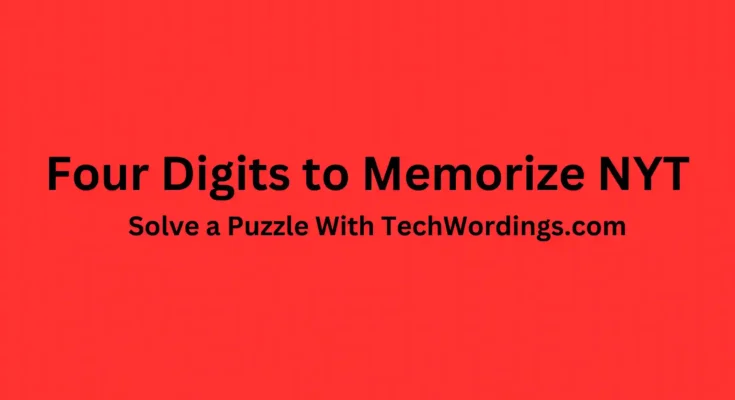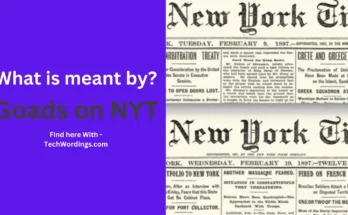Crossword puzzles have long held a special place in the hearts of puzzle enthusiasts, serving as a source of intellectual stimulation and a delightful pastime. Within the vast expanse of crossword landscapes, The New York Times crossword puzzle stands as an iconic bastion of wordplay and mental acuity. Among the myriad clues that challenge and captivate solvers, one recurring enigma has left many puzzlers intrigued: “Four Digits to Memorize NYT.” In this exploration, we embark on a journey to unravel the mystery behind this cryptic clue, dissecting its implications, and uncovering the layers of significance it holds within the realm of word games.
As crossword aficionados engage in the pursuit of filling in grids and decoding language conundrums, certain clues become more than mere wordplay; they become portals into a world of hidden meanings and thematic connections. The “Four Digits to Memorize NYT” clue is one such gateway, inviting solvers to grapple with the challenge of deciphering not just words, but a numerical code embedded within the puzzles’ fabric.
This article serves as a guide through this intriguing puzzle-scape, shedding light on the symbolism, practicality, and thematic relevance of those elusive four digits. Join us as we explore the landscape of crossword puzzles, unravel the mystery behind ‘Four Digits to Memorize NYT,’ and discover the unexpected connections between leisurely wordplay and the practicalities of everyday life.
Four Digits to Memorize NYT: The Crossword Puzzle Landscape
In the intricate world of crossword puzzles, where words intersect and minds intertwine, certain clues emerge as constants, recurring enigmas that spark curiosity and beckon the solver into a realm of linguistic challenge. Among these, the elusive “Four Digits to Memorize NYT” stands as a testament to the New York Times crossword puzzle’s ability to seamlessly blend the playful with the enigmatic.
I. The Popularity of Crossword Puzzles
Crossword puzzles have endured as a beloved pastime for generations, captivating minds and providing a mental workout wrapped in the joy of wordplay. The New York Times, with its iconic crossword, occupies a unique position in this puzzle universe. Its puzzles are not just exercises in language but cultural phenomena that have ingrained themselves in the daily routines of word enthusiasts.
II. The New York Times Crossword Puzzle as a Cultural Icon
The New York Times crossword puzzle is more than a grid of black-and-white squares; it’s a cultural touchstone that transcends mere entertainment. Published since 1942, it has become a symbol of intellectual rigor and a benchmark for wordsmiths. Each puzzle is meticulously crafted, its clues ranging from the straightforward to the delightfully cryptic.
III. Introduction of the Recurring Clue: “Four Digits to Memorize NYT”
Amidst the plethora of clues that populate a typical New York Times crossword puzzle, the recurring appearance of “Four Digits to Memorize NYT” piques the interest of solvers. What could these four digits represent? Why the emphasis on memorization? As we delve into this enigma, the crossword transforms from a mere game into a portal, inviting us to unravel its secrets.
Stay tuned as we unravel the mystery behind those four digits, exploring the intersection of language, numbers, and the captivating world of crossword puzzles. In the next section, we’ll delve into the significance of PINs and their role in the crossword puzzle landscape.
Four Digits to Memorize NYT: PINs and Their Role
As we continue our journey into the depths of the New York Times crossword puzzle, the recurring clue “Four Digits to Memorize NYT” beckons us to explore the intriguing world of Personal Identification Numbers (PINs). These humble four-digit codes, often associated with security and access, take center stage in the crossword puzzle landscape, adding a layer of complexity to the linguistic adventure.
I. Definition of PIN (Personal Identification Number)
At the heart of the mystery lies the concept of the Personal Identification Number, commonly known as a PIN. A PIN is a numerical code used to authenticate and grant access to various secured systems. Typically four digits long, this seemingly simple set of numbers plays a crucial role in safeguarding information and ensuring the privacy of individuals in the digital age.
II. Common Usage of Four-Digit PINs
While PINs are most commonly associated with bank transactions, their usage extends far beyond the realm of financial institutions. Mobile phones, credit cards, and even certain door access systems rely on the simplicity and security of four-digit PINs. The ubiquity of these codes in our daily lives transforms the act of memorizing four digits from a mere cognitive exercise into a practical necessity.
III. Significance in Security and Identification
The choice of “Four Digits to Memorize NYT” as a crossword clue is not arbitrary. It draws attention to the importance of memorizing these sequences for security and identification purposes. The crossword puzzle, typically a leisurely pursuit, subtly bridges the gap between the recreational and the practical, inviting solvers to reflect on the significance of these four digits in their daily routines.
As we uncover the layers of meaning embedded in the clue, it becomes evident that the New York Times crossword is not merely a compilation of words and definitions but a curated exploration of language, culture, and the intricacies of modern life. Join us in the next section as we delve into the thematic variations of the “Four Digits to Memorize NYT” clue and its role in shaping crossword puzzle themes.
Four Digits to Memorize NYT: Crossword Puzzle Themes
Within the symphony of words that compose a crossword puzzle, themes emerge like recurring motifs, enriching the solver’s experience and providing a narrative thread. The “Four Digits to Memorize NYT” clue, with its numerical allure, seamlessly integrates into various themes, adding a layer of complexity and intrigue to the linguistic tapestry of the New York Times crossword.
I. Exploration of Different Crossword Puzzle Themes
Crossword puzzles are not haphazardly constructed; they are meticulously designed with themes that tie together a series of clues, creating a cohesive and satisfying problem-solving experience. These themes can range from wordplay and puns to cultural references and, in the case of our enigmatic clue, numerical patterns.
II. How the Theme Influences the Answer to the Clue
The theme of a crossword puzzle serves as a guiding principle, shaping the answers to the clues within its domain. In the case of “Four Digits to Memorize NYT,” the theme could pivot around numbers, codes, or even broader concepts related to memorization and cognition. Solvers, in turn, are challenged not only to decode words but to discern the underlying theme connecting those words.
III. Examples of Other Crossword Clues with Specific Themes
To understand the role of our recurring clue, it’s insightful to explore other instances of thematic clues in crossword puzzles. Themes can range from the seasons and holidays to historical events and wordplay patterns. By examining how these themes are constructed, we gain a deeper appreciation for the artistry involved in crafting a crossword puzzle.
As we unravel the thematic variations of “Four Digits to Memorize NYT,” we begin to appreciate the versatility of this seemingly straightforward clue. Join us in the next section as we delve into notable instances of this clue’s appearance in New York Times puzzles, with a spotlight on its intriguing presence in the October 23rd, 2023 Mini Crossword.
Four Digits to Memorize NYT: Notable Instances
In the ever-evolving landscape of New York Times crossword puzzles, the recurring clue “Four Digits to Memorize NYT” has left its mark in various instances, challenging solvers and adding an element of intrigue to the daily crossword-solving ritual. As we dissect these notable occurrences, we’ll shed light on the thematic nuances and contextual variations that make this clue both familiar and unpredictable.
I. Reference to Specific Instances of the Clue in NYT Puzzles
The journey into the crossword puzzle landscape wouldn’t be complete without examining specific instances of the “Four Digits to Memorize NYT” clue. From its earliest appearances to more recent renditions, each instance offers a unique glimpse into the puzzle’s construction and the clever interplay between clues and solutions.
II. Highlighting the October 23rd, 2023 Mini Crossword Appearance
A particularly intriguing chapter in the saga of our four-digit mystery unfolded in the October 23rd, 2023 Mini Crossword. This specific puzzle captivated solvers with its compact grid and concise clues, placing “Four Digits to Memorize NYT” at the forefront of the solving experience. We’ll explore the context of this appearance, unraveling the subtle nuances that set it apart from other instances.
III. Analysis of the Context and Potential Variations in Answers
As we delve into these notable instances, it becomes apparent that the context surrounding the clue is just as crucial as the clue itself. The crossword puzzle, with its ever-shifting themes and creative constructions, allows for a spectrum of interpretations. Solvers are invited to navigate through the maze of possibilities, considering variations that stretch beyond the conventional realm of four-digit codes.
Join us in the next section as we transition from the puzzle grid to the broader landscape of puzzles and brain teasers, exploring the cognitive engagement fostered by “Four Digits to Memorize NYT” and its counterparts in the world of word games.
Four Digits to Memorize NYT: Puzzles and Brain Teasers
As we journey further into the crossword puzzle labyrinth, the recurring clue “Four Digits to Memorize NYT” unfolds as more than a mere linguistic challenge. It becomes a bridge connecting the leisurely pursuit of solving puzzles with the intricacies of memory and cognition. In this segment, we explore the cognitive engagement fostered by this enigmatic clue and its counterparts in the captivating world of word games.
I. Connection Between Puzzles and Memory Challenges
Puzzles, by their nature, demand mental dexterity and strategic thinking. The act of solving puzzles stimulates various cognitive functions, including memory. “Four Digits to Memorize NYT” transcends the traditional boundaries of wordplay by introducing an element of memorization, inviting solvers to flex their memory muscles while navigating the crossword grid.
II. Role of ‘Four Digits to Memorize NYT’ in Stimulating Cognitive Engagement
The inclusion of numerical codes within the crossword puzzle framework elevates the solving experience from a linguistic exercise to a cognitive challenge. Solvers are prompted not only to decipher words but also to commit a sequence of four digits to memory. This dual-layered engagement transforms the crossword into a mental workout, fostering cognitive agility and recall.
III. Cognitive Benefits of Solving Crossword Puzzles
Research suggests that engaging in activities that challenge the brain, such as solving crossword puzzles, can have positive effects on cognitive health. The intersection of language, memory, and problem-solving in puzzles like those featuring “Four Digits to Memorize NYT” provides a multifaceted approach to mental stimulation. It’s not just about filling in squares; it’s about keeping the mind nimble and agile.
As we navigate the intellectual terrain of crossword puzzles, the role of this recurring clue becomes ever more intriguing. Join us in the next section as we explore the broader implications of memorizing four digits, extending beyond the crossword grid into the practicalities of everyday life.
Four Digits to Memorize NYT: Beyond the Puzzles
Beyond the crossword grid, “Four Digits to Memorize NYT” extends its influence into the realm of practicality and everyday life. What initially appears as a cryptic clue in a puzzle reveals itself as a subtle bridge between the leisurely pursuit of solving crosswords and the pragmatic necessity of memorizing four digits. Join us as we unravel the broader implications of this enigmatic clue and its real-world applications.
I. Broader Implications of Memorizing Four Digits
While crossword puzzles are a leisure activity, the act of memorizing four digits holds implications that reach beyond the realms of play. The ability to commit a numerical sequence to memory is a practical skill, often employed in various aspects of modern life, from financial transactions to digital security.
II. Real-world applications of PINs and Similar Codes
The four-digit PIN, a common answer to the “Four Digits to Memorize NYT” clue, is more than just a crossword solution; it’s a ubiquitous feature in the realm of personal security. Whether accessing a bank account, unlocking a smartphone, or conducting online transactions, the memorization of a four-digit code serves as a fundamental layer of protection.
III. The Intersection of Leisure and Practicality in Crossword Puzzles
The inclusion of such practical elements within the crossword puzzle highlights the versatility and adaptability of this beloved pastime. What begins as a leisurely activity, a mental exercise filled with linguistic challenges, subtly intersects with the practicalities of everyday life. Solvers find themselves not only immersed in a wordplay adventure but also inadvertently enhancing their cognitive skills and, in this case, the ability to memorize crucial information.
As we conclude our exploration of “Four Digits to Memorize NYT,” we reflect on the intricate tapestry woven by crossword puzzles—where the seemingly trivial meets the practical, and the pursuit of leisure seamlessly integrates with the demands of modern living. In this convergence, we find a unique synergy that captures the essence of both the crossword puzzle and the enigmatic clues that make it an ever-evolving, intellectually stimulating experience.
Conclusion
In the intricate dance between words and numbers, the New York Times crossword puzzle emerges not just as a pastime but as a captivating journey through the realms of language, cognition, and practicality. The recurring clue, “Four Digits to Memorize NYT,” serves as a guiding star in this exploration, inviting solvers to decode more than just words but the nuances of memory and real-world significance.
As we’ve navigated through the crossword puzzle landscape, the enigma of those four digits has unraveled, revealing a connection between the leisurely pursuit of solving puzzles and the pragmatic demands of modern life. The humble four-digit PIN, often at the heart of this mystery, symbolizes more than just a crossword solution; it represents a bridge between the mental gymnastics of wordplay and the practicalities of safeguarding our digital existence.
The thematic variations, the notable instances, and the cognitive engagement fostered by “Four Digits to Memorize NYT” showcase the richness of the crossword experience. It’s not merely about completing a grid but about delving into the intricate interplay of language, memory, and problem-solving.
In the end, the crossword puzzle proves to be more than a game; it’s a microcosm of life’s puzzles—where seemingly unrelated pieces come together to form a meaningful whole. “Four Digits to Memorize NYT” stands as a testament to the versatility and depth inherent in this timeless pursuit. As we conclude this exploration, we invite solvers to continue their linguistic adventures, appreciating not only the words on the grid but also the mysteries and practicalities they unlock in the world beyond.


